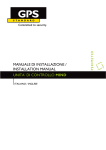Download IO.XEC
Transcript
USER’S MANUAL IO.XEC 1 BEFORE STARTING 4 1.1 1.2 1.3 1.4 4 4 5 6 INSIDE THE BOX GENERAL SPECIFICATIONS IDENTIFYING THE COMPONENTS OF IO.XEC WHAT IS NEEDED? 2 INSTALLATION 2.1 CONNECTION BLOCKS 2.2 CONNECTING 2.2.1 POWER 2.2.2 DIGITAL INPUTS 2.2.3 DIGITAL OUTPUTS 2.2.4 ANALOG INPUT 2.2.5 ANALOG TEMPERATURE SENSOR 2.2.6 ANALOG OUTPUT 2.2.7 RELATIVE HUMIDITY AND TEMPERATURE SENSOR 6 6 ERRO! MARCADOR NÃO DEFINIDO. 6 6 7 8 9 9 9 3 SETTING UP IO.XEC 10 3.1 3.2 3.3 3.4 10 11 12 13 WEB SERVER NETWORK SETTINGS HARDWARE CONFIGURATION DYNAMIC DNS CONFIGURATION 4 RETRIEVING STATUS OF IO.XEC 14 5 FACTORY DEFAULTS 14 6 HTTP API IO.XEC 15 6.1 INTRODUCTION 6.2 COMMUNICATIONS 6.2.1 SYSTEM PORT 6.2.2 AUTHENTICATION 6.2.3 PROTOCOL DESCRIPTION 6.3 DEVICE GENERAL INFORMATION 6.4 DEVICE HARDWARE CONFIGURATION 6.5 CURRENT STATUS 6.6 CHANGE IO.XEC CONFIGURATION 15 15 15 15 16 16 17 19 20 2 6.7 CONTROL IO.XEC OUTPUTS 6.7.1 DIGITAL OUTPUTS 6.7.2 ANALOG OUTPUT 6.8 REBOOT IO.XEC 20 20 21 21 7 FIRMWARE UPDATE 21 3 1 Before starting 1.1 Inside the box Inside the box, you must find IO.XEC and 5 wire connectors. 1.2 General specifications The main electrical specifications are: 8 digital opto-coupled inputs, organized in 2 groups. The activation voltage is between 8V and 24V 4 relay digital outputs 4 open-collector digital outputs 1 analog input (0-10V) 1 analog input for temperature sensor 1 analog output (0-10V) 1 RS232 port 1 USB interface expansion port 4 1.3 Identifying the components of IO.XEC Terminal block A Terminal block B Terminal block C Expansion port Status LED Ethernet port RS232 port USB connector Terminal block E Terminal block D Terminal block A Q1 Q1 Q2 Q2 Q3 Q3 Q4 Q4 Output 1 (relay) Output 1 (relay) Output 1 (relay) Output 1 (relay) Terminal block B V+ GND C1 C2 CO AT AI AO Power supply (12V) Power supply (0V) Common of inputs 1-2 Common of inputs 3-8 Common of outputs 5-8 Analog temp. sensor Analog input Analog output Terminal block C SCL 3V3 GND SDA Digital T+RH clock Digital T+RH power Digital T+RH GND Digital T+RH data 5 Terminal block D Q5 Q6 Q7 Q8 Output 5 Output 6 Output 7 Output 8 Terminal block E I1 I2 I3 I4 I5 I6 I7 I8 Input 1 Input 2 Input 3 Input 4 Input 5 Input 6 Input 7 Input 8 1.4 What is needed? To start, you’ll need: A power supply. The minimum rating is 12Vdc/1A. A working Ethernet network and an Ethernet cable, or alternatively, a cross-over Ethernet cable. A personal computer or any kind of device that can run a web browser. 2 Installation 2.1 Connection blocks 2.1.1 Power Power should be connected in the V+ and GND terminals. 2.1.2 Digital inputs The inputs are photocoupled, organized in 2 groups. The activation voltage, applied between the terminal C1 (or C2) and the input terminal, is between 8V(RMS) and 24V(RMS). Here are some examples of connection diagrams: 6 Please note that the activation voltage has no fixed polarization, therefore the terminal C1 can be connected to a positive or negative voltage. 2.1.3 Digital outputs There are two types of outputs: Q1 to Q4 are relay outputs, capable of switching 8A, and Q5 to Q8 are open collector outputs. The following diagram shows how to connect a lamp using Q1. 7 If needed, more relays can be added. The following diagram shows how to connect an external relay to a open collector output. 2.1.4 Analog input The analog input voltage must be connected to the AI terminal. The reference is GND. When not in use, this feature should be disabled, in order to prevent erroneous behavior. Please consult section 3.3. 8 2.1.5 Analog temperature sensor The device supports 2 different sensors: LM35DZ and MCP9701. In both of them, the output signal should be connected to the AT terminal. The reference is GND. Regarding power supply to the sensor, the LM35DZ can be powered using terminals V+ and GND, while MCP9701 can be powered using terminals 3V3 and GND. To choose between the two, you have to access the IO configuration page. When not in use, this feature should be disabled, in order to prevent erroneous behavior. Please consult section 3.3. 2.1.6 Analog output The analog output is connected to AO terminal. The reference is GND. 2.1.7 Relative humidity and Temperature sensor IO.XEC supports Sensirion SHT75 relative humidity and temperature sensor. Please consult the sensor datasheet. The terminals to use are SDA, SCL, 3V3, GND. When not in use, this feature should be disabled, in order to prevent erroneous behavior. Please consult section 3.3. 9 3 Setting up IO.XEC All the configuration and setup of IO.XEC is made using a browser. There are no serviceable parts inside the enclosure. 3.1 Web server To reach IO.XEC web server, you have to use a browser like Microsoft Internet Explorer®, Mozilla Firefox® or Google Chrome®. The device checks if there is a DHCP server in the network. If present, the IP address is updated with the address leased by the DHCP server. If not, IO.XEC will address itself with 169.254.1.1. In order to connect to IO.XEC, the computer running the browser must be in the same network. Weather the DHCP server is present, as IO.XEC has a NETBIOS name server built in, it will always respond to a network name instead of an address. The default name is IOXEC. In conclusion, you can access IO.XEC web server using this link: http://IOXEC 10 3.2 Network settings In order to change the network settings, select the “Network settings” tab. After these settings are validated, IO.XEC reboots to apply the new values. 11 3.3 Hardware configuration Select “IO settings“ to reach this page, where you can enable and disable some hardware features of IO.XEC. 12 3.4 Dynamic DNS configuration Dynamic DNS allows you to access your network using domain names instead of IP addresses. The service manages changing IP addresses and updates your domain information dynamically. This feature, along with proper port forwarding in place at the router, can enable global access to this device behind a NAT router or firewall. Before setting up this feature, you must sign up this service! To access this page, select the “Dynamic DNS” tab. 13 4 Retrieving status of IO.XEC The status of IO.XEC can be retrieved using a browser (see section 3.1). The “IO status” tab should be selected. The status page refreshes itself automatically at time intervals of 500ms. The page also allows to control the outputs (digital and analog) 5 Factory defaults The factory defaults of IO.XEC are: NetBIOS name: DHCP: IP address: Subnet mask: Gateway: Primary DNS: Secondary DNS: IOXEC on 169.254.1.1 255.255.0.0 169.254.1.1 169.254.1.1 0.0.0.0 14 Username: Password: admin ioxec To reset the settings to the factory defaults, do the following: 1. With IO.XEC turned on, push and hold the reset button. The with LED lights steady. 2. Hold the reset, until the LED starts flashing 3. Release the reset button, and IO.XEC will boot with the default settings. 6 HTTP API of IO.XEC 6.1 Introduction This section describes the HTTP API of IO.XEC devices. This Application Programming Interface (API) permits the integration of this device in third party services and applications. IO.XEC allows access to all its functionality via a proprietary HTTP API. Thought this API, third party applications can control, if authenticated, the outputs of the device , retrieve the status of the inputs and analog values as well. The API implements a bridge between an automation application and physical inputs, outputs and sensors. 6.2 Communications Data is exchanged trough TCP/IP protocol. This HTTP API it is based on the HTTP protocol which goes on top of TCP data links. 6.2.1 System port The port used is the default for HTTP connections: 80. 6.2.2 Authentication 15 Authentication uses Base64 encoding, generally called Basic Authentication1. The user name is appended with a colon and concatenated with the password. The resulting string is encoded with the Base64 algorithm. Example: User 'admin' with Password '1234'. These are concatenated into 'admin:1234' which then gets encoded with base64. The final encoded string is “YWRtaW46MTIzNA==”. All the requests (except for the one described in section 6.3) need the authentication described above! 6.2.3 Protocol description Data is passed on HTTP (GET) requests. Please note that integer variables and all other are sent as ASCII text/strings as usual on HTTP requests. The HTTP requests described use <address> to represent IO.XEC current IP address. The network name (NetBIOS name) can also be used. 6.3 Device general information The device general configuration can be obtained, retrieving the file home.xml from IO.XEC. The location of the file is: http://<address>/home.xml No authentication is needed for this file. Example: <response> <name>IOXEC</name> <version>3.0.3LT</version> <dhcp>1</dhcp> <ip>192.168.1.119</ip> <subnet>255.255.255.0</subnet> <gateway>192.168.1.254</gateway> <dns1>192.168.1.11</dns1> <dns2>0.0.0.0</dns2> <mac>00:04:A3:3A:F1:E8</mac> <defuser>admin</defuser> <defpassw>ioxec</defpassw> </response> 1 http://en.wikipedia.org/wiki/Basic_access_authentication 16 6.4 Device hardware configuration The device configuration can be obtained, retrieving the file ioconfig.xml from IO.XEC. The location of the file is: http://<address>/protect/ioconfig.xml Example: <response> <all_configs> <anain option="0"> <option_name>Disabled</option_name> <min_val>--</min_val> <max_val>--</max_val> <precision>--</precision> </anain> <anain option="1"> <option_name>Enabled</option_name> <min_val>0.00</min_val> <max_val>10.00</max_val> <precision>0.01</precision> </anain> <anatemp option="0"> <option_name>Disabled</option_name> <min_val>--</min_val> <max_val>--</max_val> <precision>--</precision> </anatemp> <anatemp option="1"> <option_name>LM35</option_name> <min_val>0.0</min_val> <max_val>150.0</max_val> <precision>0.1</precision> </anatemp> <anatemp option="2"> <option_name>MCP9701</option_name> <min_val>-40.0</min_val> <max_val>125.0</max_val> <precision>0.1</precision> </anatemp> <digtrh option="0"> <option_name>Disabled</option_name> <min_val_t>--</min_val_t> <max_val_t>--</max_val_t> <precision>--</precision> <min_val_rh>--</min_val_rh> <max_val_rh>--</max_val_rh> <precision>--</precision> </digtrh> <digtrh option="1"> <option_name>SHT75</option_name> <min_val_t>-40.0</min_val_t> 17 <max_val_t>100.0</max_val_t> <precision>0.1</precision> <min_val_rh>0.0</min_val_rh> <max_val_rh>100.0</max_val_rh> <precision>0.1</precision> </digtrh> <anaout> <min_val>0.00</min_val> <max_val>10.00</max_val> <precision>0.01</precision> </anaout> <din index="0"> <label>Input 1</label> <group>0</group> </din> <din index="1"> <label>Input 2</label> <group>0</group> </din> <din index="2"> <label>Input 3</label> <group>1</group> </din> <din index="3"> <label>Input 4</label> <group>1</group> </din> <din index="4"> <label>Input 5</label> <group>1</group> </din> <din index="5"> <label>Input 6</label> <group>1</group> </din> <din index="6"> <label>Input 7</label> <group>1</group> </din> <din index="7"> <label>Input 8</label> <group>1</group> </din> <dout index="0"> <label>Output 1</label> <type>relay</type> </dout> <dout index="1"> <label>Output 2</label> <type>relay</type> </dout> <dout index="2"> <label>Output 3</label> <type>relay</type> </dout> <dout index="3"> <label>Output 4</label> 18 <type>relay</type> </dout> <dout index="4"> <label>Output 5</label> <type>openc</type> </dout> <dout index="5"> <label>Output 6</label> <type>openc</type> </dout> <dout index="6"> <label>Output 7</label> <type>openc</type> </dout> <dout index="7"> <label>Output 8</label> <type>openc</type> </dout> <dout index="8"> <label>Buzzer</label> <type>buzz</type> </dout> </all_configs> <current_config> <anain> <option>0</option> </anain> <anatemp> <option>0</option> </anatemp> <digtrh> <option>1</option> </digtrh> </current_config> </response> 6.5 Current status The device status may be obtained by getting the file iostatus.xml from IO.XEC. The location of the file is: http://<address>/protect/status.xml The value of each digital input is concatenated in the field “in” of the above file. The same operation is done with the outputs, in the field “out”. In this case, the status of the buzzer is also concatenated, as if it were the 9th output. The fields marked with “-- “ are inactive. Example: <response> <in>00000000</in> 19 <out>000000000</out> <anatemp>--</anatemp> <anain>--</anain> <anaout>0.00</anaout> <digtemp>17.4</digtemp> <digrh>78.8</digrh> </response> 6.6 Change IO.XEC configuration It is possible to change the hardware configuration of IO.XEC, as described on section 3.3. The HTTP request has the following structure: http://<address>/protect/ioconfig.cgi?anain=x&anatemp=y&temprh=z The parameters x, y, z are the possible options present in the field “option” of ioconfig.xml. Example: To disable analogue input, enable LM35 temperature sensor and disable digital temperature and relative humidity sensor: http://ioxec/protect/ioconfig.cgi?anain=0&anatemp=1&temprh =0 6.7 Control IO.XEC outputs 6.7.1 Digital outputs To change a digital output, issue the following HTTP (GET) request: http://<address>/protect/set.cgi?outx=val Where: x: Output identifier. The following identifiers can be used: 0..7: digital outputs 8: internal buzzer val: Resulting value. The following values can be used: 0: resets output 1: sets output t: toggles output Examples: To reset output 0: 20 http://ioxec/protect/set.cgi?out0=0 To toggle output 3: http://ioxec/protect/set.cgi?out3=t To turn on the internal buzzer: http://ioxec/protect/set.cgi?out8=1 6.7.2 Analog output To change the analogue value of the analog output, issue the following HTTP (GET) request: http://<address>/protect/set.cgi?aout=val Where val is the desired voltage of the output. Example: To set the output voltage to 2.55Volt http://ioxec/protect/set.cgi?aout=2.55 6.8 Reboot IO.XEC To reboot IO.XEC use the following HTTP (GET) request: http://<address>/protect/reboot.cgi 7 Firmware update The IO.XEC firmware is updateble. With this feature, IO.XEC can run the most up to date firmware revision. This operation is very simple and is supposed to be done by the user or installer. You need an USB flash drive in order to proceed. The steps needed to make a firmware update are the following: 1. Download the firmware image from io.xec website (http://ioxec.ideiao.com). A file named image.bin 2. Copy the file to the root directory (folder) of the USB flash drive 21 3. Turn off IO.XEC 4. Insert the USB flash drive in USB connector 5. With a sharp object (a pencil, for example) push and hold the reset button (see section 1.3) 6. Turn on IO.XEC holding the reset button 7. Release the reset button 8. If the image is found, the device will start updating itself. During this process the white LED will flash 9. When finished, IO.XEC reboots This process may reset the device with the factory defaults. 22



































